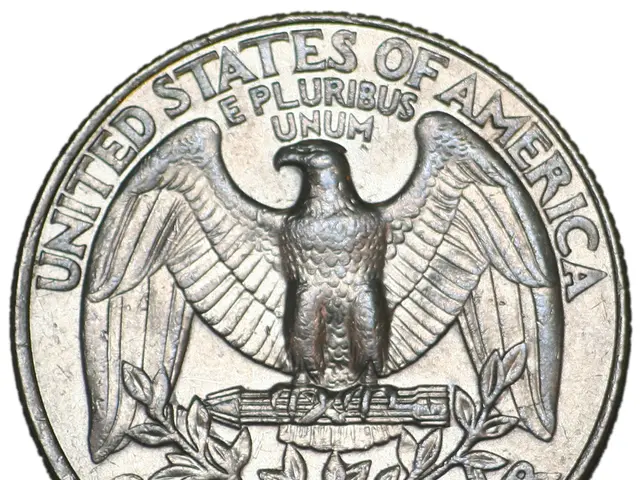Exploring the Potential Size of a Trump DOGE Dividend
What could the magnitude of a Trump-linked DOGE dividend payment amount to?
In recent discussions, a creative idea known as the Trump DOGE Dividend has gained traction. This proposal aims to channel 20% of potential federal savings straight into direct payments for American households. James Fishback initially introduced this concept, with the goal being to direct 20% of the savings generated by the Department of Government Efficiency directly back to the public.
On Wednesday, President Trump expressed his support for this innovative idea, recognizing its potential as both a policy tool and a powerful branding statement [1]. A key question still lingers: just how substantial could a potential DOGE dividend be? Let's examine various estimates and the two vital factors that would influence a DOGE dividend.
The Birth of the $5,000 Trump DOGE Dividend
The genesis of the $5,000 Trump DOGE Dividend lies in the simple yet ambitious idea that, if DOGE manages to amass a staggering $2 trillion in savings, 20% of that - an impressive $400 billion - could be redistributed as a refund to taxpaying households. Divided among approximately 79 million households, this sum would total around $5,000 per residence [1, 5].
The Origins of the $8,000 Trump DOGE Dividend
Adding an intriguing twist to the discussion, a popular TikTok video recently gained traction, suggesting that the payout could reach an astounding $8,000 per household, with over five million views [2]. However, it's crucial to note that this video fails to provide substantial evidence or a clear methodology to justify this high payout figure [2].
While curious, the $8,000 Trump DOGE Dividend figure remains doubtful since it lacks proper backing [2].
Uncovering the Mathematics Behind the Trump DOGE Dividend: Two Crucial Variables
In the end, a potential Trump DOGE Dividend hinges on two fundamental factors: the savings DOGE might achieve and the number of eligible households.
Savings Realization (The Numerator for the Trump DOGE Dividend):
The Department of Government Efficiency (DOGE) sets a daunting goal of securing $2 trillion in savings, a significant achievement that would reflect a groundbreaking efficiency breakthrough within government operations. There's a fair share of skepticism regarding the likelihood of DOGE achieving this ambitious target [1]. Musk himself has voiced reservations, saying in January that the $2 trillion figure was merely a "best-case scenario" and that there was a "good chance" of reaching only half [1]. If the overall savings amount falls short, the potential dividend could shrink consequently, reducing the payout for each eligible household.
Eligible Households (The Denominator for the Trump DOGE Dividend):
Originally, Fishback proposed distributing the refund among approximately 79 million tax-paying households [1, 5]. Yet, IRS data indicates that nearly 40% to 50% of American households, particularly those at the lower end of the income scale, report zero federal income tax liability in any given year [3]. Considering there are roughly 128 million total households in the U.S., a significant proportion doesn't contribute to the federal income tax basis.
This raises an important policy dilemma: is the aim to reward only those who pay taxes or to extend the benefit to a broader segment of the population? Offering the dividend to taxpaying households alone would likely trigger strong opposition and equity concerns (as was the case with some pandemic stimulus payments). However, if policymakers decide to broaden the dividend's reach to non-taxpayers, the denominator would increase significantly, thereby reducing per-household payouts.
Conclusion: The Trump DOGE Dividend Amount: Unresolved Questions and Estimates
The Trump DOGE Dividend, with its promise of transforming efficiency gains into tangible benefits for Americans, represents an innovative approach to fiscal policy. The idea is to directly tie government performance to public rewards. However, many elements still remain unresolved, including the feasibility of reaching the $2 trillion savings target and establishing the number of eligible households.
Trump's support for the DOGE Dividend and the disparate estimates - ranging from the basic $5,000 calculation to the intriguing, though dubious, $8,000 possibility - reveal the potential and challenges of this groundbreaking proposal. As the conversation evolves, objective data and a clear methodology will be vital in determining how, and for whom, the potential DOGE dividend could ultimately work in practice.
Sources:
- The Trump Dogecoin Dividend: $5,000 checks for every taxpayer?
- Dogecoin is the Biden-currencies plan of choice on TikTok
- Flashback: Very Few Households Pay Federal Income Tax
- James Fishback on The Trump DOGE Dividend
Enrichment Data:
The $5,000 Trump DOGE Dividend potential is an estimate based upon several factors:
- DOGE Savings: $2 trillion savings
- Return Percentage: 20% of the savings are returned to taxpayers
- Number of Households: 79 million American households that pay income taxes
If DOGE manages to save $2 trillion, 20% of this sum would result in $400 billion. Dividing this by 79 million households would yield an approximate $5,000 payment per residence. If the actual savings are lower, the potential dividend will be proportionally smaller. Per-household payouts.
- Despite President Trump's support, the feasibility of realizing a $2 trillion savings target for the Trump DOGE Dividend remains uncertain, as recognized by Elon Musk himself.
- The suggestion of a $8,000 Trump DOGE Dividend through a TikTok video lacks substantial evidence and a clear methodology, leaving the figure questionable.
- The Trump DOGE Dividend relies on two critical factors: the DOGE-generated savings and the number of eligible households for the refund.
- If the DOGE savings fall short, the potential dividend could decrease, reducing the payout for eligible households.
- The proposed distribution of the refund among tax-paying households raises equity concerns, while extending the benefit to non-taxpayers could reduce per-household payouts due to a larger denominator.
- Unresolved questions and the need for objective data and a clear methodology are crucial for determining the feasibility of the Trump DOGE Dividend and its potential impact on American households.






